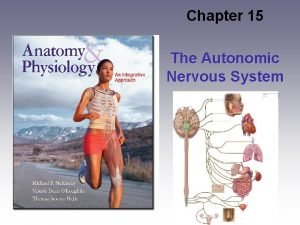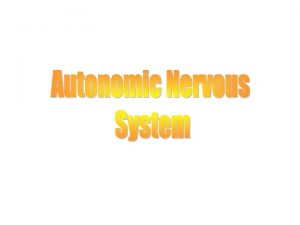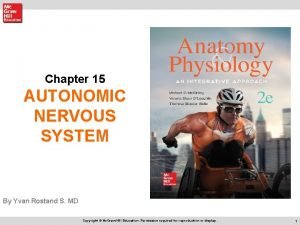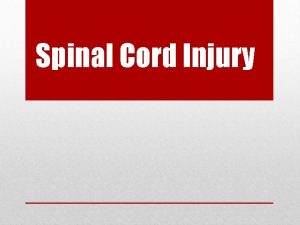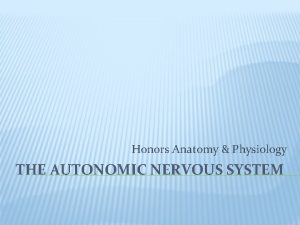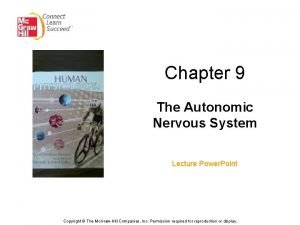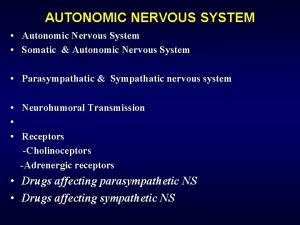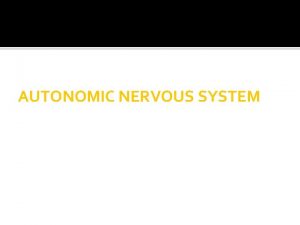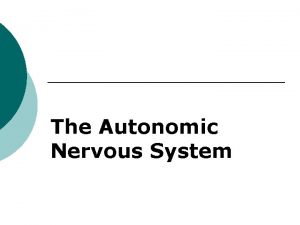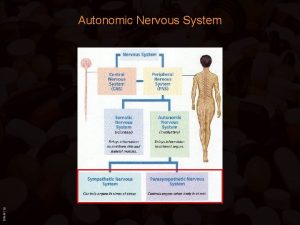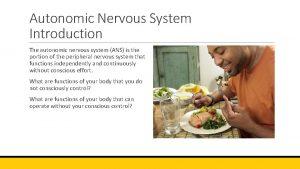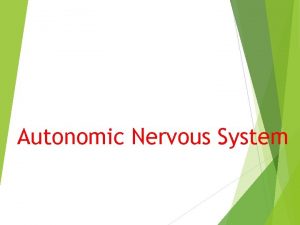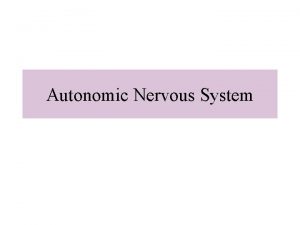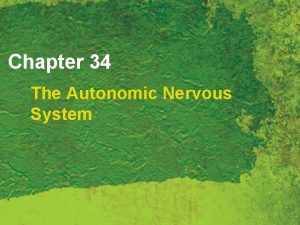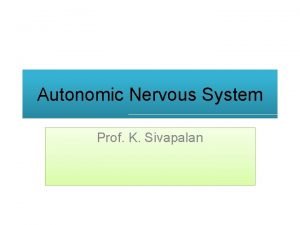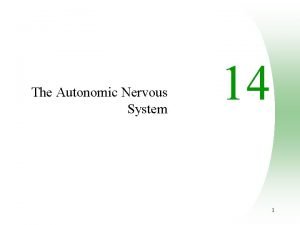Nervous System Autonomic Nervous System Reading Chapter 9

















- Slides: 17

Nervous System Autonomic Nervous System Reading: Chapter 9 1

General Functions of the Nervous System 1. Receives sensory input 2. Integrates and processes information 3. Motor output to effectors 2

Organization of the Vertebrate Nervous System Anatomical: CNS (brain + spinal cord) PNS (12 pairs cranial + 31 pairs spinal nerves) Functional: (Chart) 3

Nervous System PNS CNS Integration & Interpretation Sensory Somatic Motor Visceral Somatic (voluntary) Autonomic (involuntary) Sympathetic Parasympathetic 4

Quick Terminology Review Ganglia = cell body OUTSIDE of CNS 5

Motor Control in the PNS Somatic (carcass ONLY) ONLY -1 nerve cell -no ganglia ___Autonomic (viscera mostly) -2 cells (pre- & post-ganglionic) -ganglia (sympathetic chain, collateral & terminal ganglia) -excitatory OR inhibitory -skeletal muscle -smooth & cardiac muscle, glands -specialized neuromuscular jxn. -whole organ is reactive -voluntary -involuntary -fast, myelinated -slow, little myelination -cranial OR spinal -Acetylcholine AND norepinephrine 6 overhead

7

Divisions of the Autonomic NS • Divided into Parasympathetic & Sympathetic • Divisions = bilateral (on both sides of body) • Most organs have dual innervation (PS & S) • PS & S systems generally work antagonistically 8

Parasympathetic vs. Rest & Digest Sympathetic Fight or Flight craino-sacral (Cranial III, VII, IX, X, S 2 -4) thoracol-umbar (T 1 to L 2) “long” – “short” – “long” Ach / NE in visceral cavity ONLY in carcass (vasomotor control) & viscera terminal ganglia in/near effector chain & collateral ganglia no mass discharge possible 9

10

11

Autonomic Neurotransmitters -Preganglionic fibers of _sympathetic and parasympathetic__ secrete: acetlycholine and are called: cholinergic _________ -Parasympathetic Postganglionic fibers are cholinergic and secrete: acetylcholine Most sympathetic postganglionic fibers secrete: _norepinephrine (noradrenalin) and are called adrenergic 12

Adrenal Gland Sympathetic NS control • Only 1 cell (no ganglia) • Adrenal gland acts as the post-ganglionic neuron • Adrenal gland secretes epinephrine (85%) & norepinephrine (15%) HORMONES • Hormones: Adrenalin= epinephrine Noradrenalin = Nor epinephrine These hormones intensify the response of sympathetic postganglionic fibers 13

Effect of Sympathetic & Parasympathetic Stimulation on Various Organs Example: Tiger vs. You 14

Some Effects of the Autonomic NS 15

Neural vs. Endocrine Communication Neural -electrical/hardwired -fast -short-term changes -no direct effect on met. -some voluntary actions -reflexes Endocrine -chemical -slow -long-term and/or cyclical changes -affects metabolism -involuntary 16

END 17
 Somatic motor pathway
Somatic motor pathway Autonomic nervous system muscles
Autonomic nervous system muscles Autonomic nervous system consists of
Autonomic nervous system consists of Autonomic receptors
Autonomic receptors Visceral reflex
Visceral reflex Autonomic nervous system
Autonomic nervous system The autonomic nervous system controls
The autonomic nervous system controls Adrenal gland sympathetic nervous system
Adrenal gland sympathetic nervous system Autonomic nervous system
Autonomic nervous system Major division of nervous system
Major division of nervous system Label the different types of neuronal pools in the figure.
Label the different types of neuronal pools in the figure. Sensory input and motor output
Sensory input and motor output Processes neuron
Processes neuron While reading activities
While reading activities Autonomic nerveous system
Autonomic nerveous system Autonomous vs automatic bladder
Autonomous vs automatic bladder Visceral reflex arc in order
Visceral reflex arc in order Terminal ganglia
Terminal ganglia





